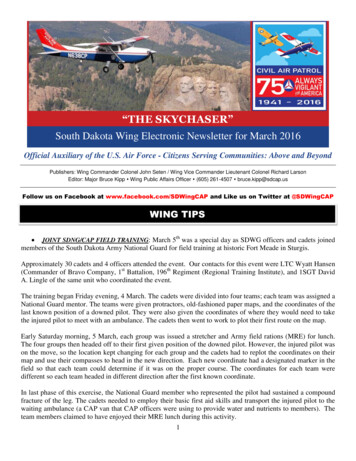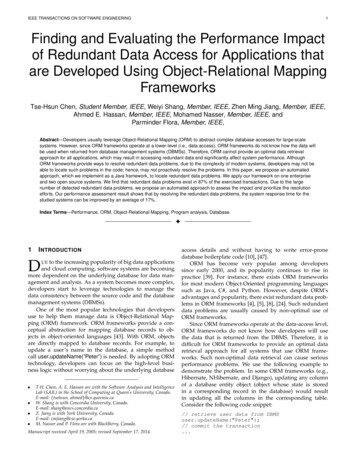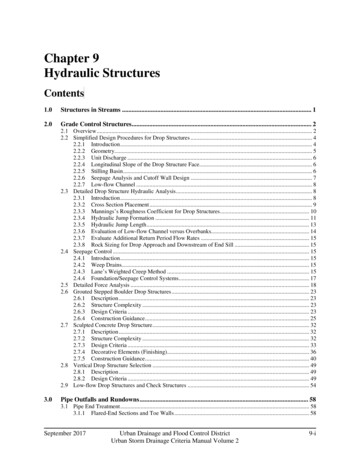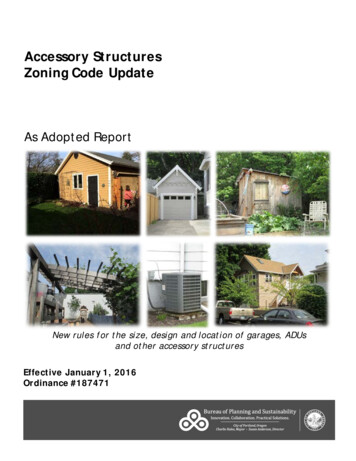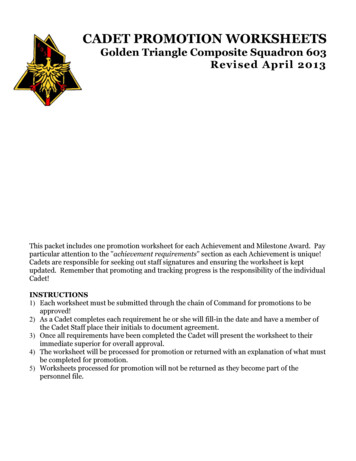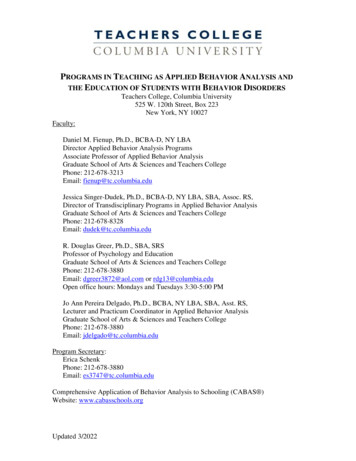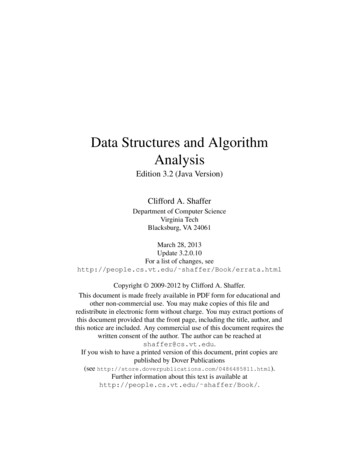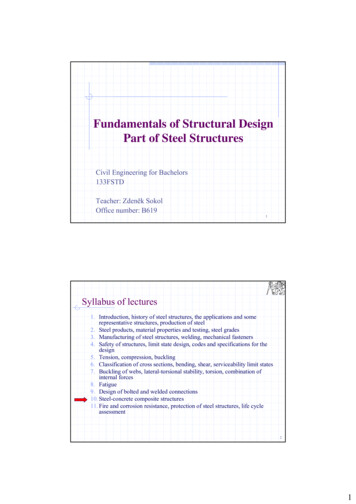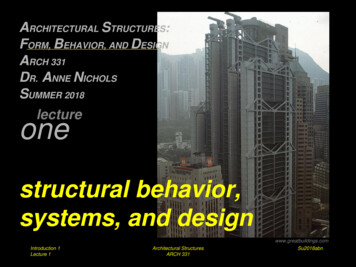
Transcription
ARCHITECTURAL STRUCTURES:FORM, BEHAVIOR, AND DESIGNARCH 331DR. ANNE NICHOLSSUMMER 2018lectureonestructural behavior,systems, and designwww.greatbuildings.comIntroduction 1Lecture 1Architectural StructuresARCH 331Su2018abn
Syllabus & Student UnderstandingsIntroduction 2Lecture 1Architectural StructuresARCH 331Su2018abn
Course Description statics– physics of forces and reactions on bodiesand systems– equilibrium (bodies at rest) structures– something made up of interdependentparts in a definite pattern of organization design– assessing and meeting structuralrequirements of parts and the wholeIntroduction 3Lecture 1Architectural StructuresARCH 331Su2018abn
Course Description mechanics of materials– external loads and effect on deformablebodies– use it to answer question if structure meetsrequirements of stability and equilibrium strength and stiffness– other principle building requirements economy, functionality and aestheticsIntroduction 4Lecture 1Architectural StructuresARCH 331Su2018abn
Structure Requirements stability &equilibrium– STATICSIntroduction 5Lecture 1Architectural StructuresARCH 331Su2018abn
Structure Requirements (cont) strength &stiffness– concerned withstability ofcomponentsIntroduction 6Lecture 1Architectural StructuresARCH 331Su2018abn
Structural System Selection kind & size of loadsbuilding functionsoil & topology of sitesystems integrationfire ratingconstruction ( , schedule)architectural formIntroduction 7Lecture 1Architectural StructuresARCH 331Su2018abn
Knowledge Required external forcesinternal forcesmaterial propertiesmember crosssections ability of a material to resist breaking structural elements that resist excessive– deflection– deformationIntroduction 8Lecture 1Architectural StructuresARCH 331Su2018abn
Problem Solving1. STATICS:equilibrium of external forces,internal forces, stresses2. GEOMETRY:cross section properties, deformations andconditions of geometric fit, strains3. MATERIAL PROPERTIES:stress-strain relationship for each materialobtained from testingIntroduction 9Lecture 1Architectural StructuresARCH 331Su2018abn
Relation to Architecture“The geometry and arrangement of theload-bearing members, the use ofmaterials, and the crafting of joints allrepresent opportunities for buildings toexpress themselves. The bestbuildings are not designed byarchitects who after resolving theformal and spatial issues, simply askthe structural engineer to make sure itdoesn’t fall down.” -Onouye & KaneStatics and Strength of Materials forArchitecture and Building ConstructionIntroduction 10Lecture 1Architectural StructuresARCH 331Su2018abn
Architectural Space and Form evolution traced to developments instructural engineering and materialtechnology–––––Introduction 11Lecture 1stone & masonrytimberconcretecast iron, steeltensile fabrics, pneumatic structures.Architectural StructuresARCH 331Su2018abn
Architectural Space and Form structure is a device for channelingloads that result from the use and/orpresence of the building to the ground––––span a roofhold up a floorcross a riversuspend a canopywww.pbs.org/wgbh/buildingbig/Introduction 12Lecture 1Architectural StructuresARCH 331Su2018abn
Structural Action axial tension bending axial compressionIntroduction 13Lecture 1Architectural StructuresARCH 331Su2018abn
Structural Action member breadth & depthIntroduction 14Lecture 1Architectural StructuresARCH 331Su2018abn
Structural Action stabilizationIntroduction 15Lecture 1Architectural StructuresARCH 331Su2018abn
Structural Action shear & bracingIntroduction 16Lecture 1Architectural StructuresARCH 331Su2018abn
Structural Action lateral resistanceIntroduction 17Lecture 1Architectural StructuresARCH 331Su2018abn
Structural Action twistingIntroduction 18Lecture 1Architectural StructuresARCH 331Su2018abn
Structural Design planning preliminary structuralconfiguration determination of loads preliminary memberselection analysis evaluation design revision final designIntroduction 19Lecture 1Architectural StructuresARCH 331Su2018abn
Structural Loads STATIC and DYNAMICdead load– static, fixed, includesbuilding weight, fixedequipment live load– transient and movingloads (includingoccupants), snowfallIntroduction 20Lecture 1Architectural StructuresARCH 331Su2018abn
Structural Loads wind loads– dynamic, wind pressures treated as lateralstatic loads on walls, up or down loads onroofsIntroduction 21Lecture 1Architectural StructuresARCH 331Su2018abn
Structural Loads earthquake loads– seismic, movement ofgroundIntroduction 22Lecture 1Architectural StructuresARCH 331Su2018abn
Structural Loads impact loads– rapid, energy loadsIntroduction 23Lecture 1Architectural StructuresARCH 331Su2018abn
Structural Loads gravity acts on mass (F m*g) force of mass– acts at a point ie. joist on beam– acts along a “line” ie. floor on a beam– acts over an area ie. people, books,snow on roof or floorIntroduction 24Lecture 1Architectural StructuresARCH 331Su2018abn
Structural Math quantify environmental loads– how big is it? evaluate geometry and angles– where is it?– what is the scale?– what is the size in a particular direction? quantify what happens in the structure– how big are the internal forces?– how big should the beam be?Introduction 25Lecture 1Architectural StructuresARCH 331Su2018abn
Structural Math physics takes observable phenomenaand relates the measurement with rules:mathematical relationships need– reference frame– measure of length, mass, time, direction,velocity, acceleration, work, heat,electricity, light– calculations & geometryIntroduction 26Lecture 1Architectural StructuresARCH 331Su2018abn
Structural Organization classifications– geometry line-forming surface-forming– stiffness rigid flexible– one-way or two-way spatial organization and load transfer– materialsIntroduction 27Lecture 1Architectural StructuresARCH 331Su2018abn
Structural Components bearing wallscolumnsbeamsflat platestrussesarchesshellscablesIntroduction 28Lecture 1Architectural StructuresARCH 331Su2018abn
Bearing WallsIntroduction 29Lecture 1Architectural StructuresARCH 331Su2018abn
Bearing Walls behavior as “deep beams”Introduction 30Lecture 1Architectural StructuresARCH 331Su2018abn
Columns & WallsIntroduction 31Lecture 1Architectural StructuresARCH 331Su2018abn
Beams & PlatesIntroduction 32Lecture 1Architectural StructuresARCH 331Su2018abn
Beams & PlatesIntroduction 33Lecture 1Architectural StructuresARCH 331Su2018abn
Trusses and ShellsIntroduction 34Lecture 1Architectural StructuresARCH 331Su2018abn
Arches and CablesIntroduction 35Lecture 1Architectural StructuresARCH 331Su2018abn
Building Framing Components or AssemblagesIntroduction 36Lecture 1Architectural StructuresARCH 331Su2018abn
Building FramingIntroduction 37Lecture 1Architectural StructuresARCH 331Su2018abn
System Selection evaluation of alternativesIntroduction 38Lecture 1Architectural StructuresARCH 331Su2018abn
System SelectionIntroduction 39Lecture 1Architectural StructuresARCH 331Su2018abn
Structural Design Criteria components stay together structure acts as whole to be stable– resist sliding– resist overturning– resist twisting and distortion internal stability– interconnectedness strength & stiffnessIntroduction 40Lecture 1Architectural StructuresARCH 331Su2018abn
Structural Design Sequences first-order design– structural type and organization– design intent– contextual or programmatic second-order– structural strategies– material choice– structural systems third-order– member shaping & sizingIntroduction 41Lecture 1Architectural StructuresARCH 331Su2018abn
Systems by Materials WoodSteelConcreteMasonryCompositeIntroduction 42Lecture 1Architectural StructuresARCH 331Su2018abn
Wood columns beams trussesIntroduction 43Lecture 1Architectural StructuresARCH 331Su2018abn
Timber Construction all-wood framing systems– studs, beams, floordiaphragms, shearwalls– glulam arches & frames– post & beams– trusses composite construction– masonry shear walls– concrete– steelIntroduction 44Lecture 1Architectural StructuresARCH 331Su2018abn
Timber Construction studs, beams floor diaphragms & shear wallsIntroduction 45Lecture 1Architectural StructuresARCH 331Su2018abn
Timber Construction glulam arches & frames– manufactured or custom shapes– glue laminated– bigger membersIntroduction 46Lecture 1Architectural StructuresARCH 331Su2018abn
Timber Construction post & beam trussesIntroduction 47Lecture 1Architectural StructuresARCH 331Su2018abn
Timber Construction composite constructionIntroduction 48Lecture 1Architectural StructuresARCH 331Su2018abn
Steel cast iron – wrought iron - steelcablescolumnsbeamstrussesframesIntroduction 49Lecture 1http:// nisee.berkeley.edu/goddenArchitectural StructuresARCH 331Su2018abn
Steel Construction standard rolled shapesopen web joistsplate girdersdeckingIntroduction 50Lecture 1Architectural StructuresARCH 331Su2018abn
Steel Construction welding boltsIntroduction 51Lecture 1Architectural StructuresARCH 331Su2018abn
Steel Construction fire proofing– cementicious spray– encasement in gypsum– intumescent – expandswith heat– sprinkler systemIntroduction 52Lecture 1Architectural StructuresARCH 331Su2018abn
Concrete columnsbeamsslabsdomesfootingsIntroduction 53Lecture 1Architectural Structures http:// nisee.berkeley.edu/goddenARCH 331Su2018abn
Concrete Construction roduction 54Lecture 1Architectural StructuresARCH 331http:// nisee.berkeley.edu/goddenSu2018abn
Concrete Floor Systems types & spanning directionIntroduction 55Lecture 1Architectural StructuresARCH 331Su2018abn
Concrete Floor SystemsIntroduction 56Lecture 1Architectural StructuresARCH 331Su2018abn
Masonry (& Stone) columnswallslintelsbeamsarchesfootingsIntroduction 57Lecture 1Architectural StructuresARCH 331Su2018abn
Grids and Patterns often adopted early in design– give order– cellular, ex. vertical and horizontal square and rectangular– single-cell– aggregated baysIntroduction 58Lecture 1Architectural StructuresARCH 331Su2018abn
Grids and PatternsIntroduction 59Lecture 1Architectural StructuresARCH 331Su2018abn
Systems total of components behavior of whole classifications– one-way– two-way– tubes– braced– unbracedIntroduction 60Lecture 1Architectural StructuresARCH 331Su2018abn
One-Way Systems horizontal vs. verticalIntroduction 61Lecture 1Architectural StructuresARCH 331Su2018abn
Two-Way Systems spanning system less obvious horizontal– plates– slabs– space frames vertical– columns– wallsIntroduction 62Lecture 1Architectural StructuresARCH 331Su2018abn
Two-Way SystemsIntroduction 63Lecture 1Architectural StructuresARCH 331Su2018abn
Roof Shapes coincide withinIntroduction 64Lecture 1Architectural StructuresARCH 331Su2018abn
Tubes & Cores stiffnessIntroduction 65Lecture 1Architectural StructuresARCH 331Su2018abn
Span Lengths crucial in selectionof system maximum spanson charts aren’tabsolute limits,but usual maximums increase L, increase depth2 required(ex. cantilever) deflections depend on LIntroduction 66Lecture 1Architectural StructuresARCH 331Su2018abn
Approximate DepthsIntroduction 67Lecture 1Architectural StructuresARCH 331Su2018abn
Loading Type and Structure Type light uniform loads– surface forming elements– those that pick up first load dictate spacingof other elements heavy concentrated loads– member design unique distributed vs. concentrated structuralstrategies– large beam vs. many smaller onesIntroduction 68Lecture 1Architectural StructuresARCH 331Su2018abn
Design Issues lateral stability – all directionsIntroduction 69Lecture 1Architectural StructuresARCH 331Su2018abn
Design Issues configurationIntroduction 70Lecture 1Architectural StructuresARCH 331Su2018abn
Design Issues vertical load resistancewallsIntroduction 71Lecture 1columnsArchitectural StructuresARCH 331Su2018abn
Design Issues lateral load resistanceIntroduction 72Lecture 1Architectural StructuresARCH 331Su2018abn
Design Issues lateral load resistanceIntroduction 73Lecture 1Architectural StructuresARCH 331Su2018abn
Design Issues multi-story– cores, tubes, braced framesIntroduction 74Lecture 1Architectural StructuresARCH 331Su2018abn
Design Issues multi-story– avoid discontinuities vertically horizontallyIntroduction 75Lecture 1Architectural StructuresARCH 331Su2018abn
Foundation Influence type may dictate fit– piles vs. mats vs. spread– capacity of soil to sustainloads high capacity – smaller areaof bearing needing and canspread out low capacity – multiplecontacts and big distributionareasIntroduction 76Lecture 1Architectural StructuresARCH 331Su2018abn
Grid Dependency on Floor Height wide grid deep beams– increased building height– heavier– foundation design codes and zoningmay limit utilize depth formechanicalIntroduction 77Lecture 1Architectural StructuresARCH 331Su2018abn
Large Spaces ex. auditoriums, gyms, ballrooms choices– separate two systemscompletely and connectalong edges– embed in finer grid– staggered trussIntroduction 78Lecture 1Architectural StructuresARCH 331Su2018abn
Meeting of Grids common to use more than one grid intersection important structurally can use different structural materials– need to understand their properties mechanical thermalIntroduction 79Lecture 1Architectural StructuresARCH 331Su2018abn
Meeting of Grids horizontal choicesIntroduction 80Lecture 1Architectural StructuresARCH 331Su2018abn
Meeting of Grids vertical choicesIntroduction 81Lecture 1Architectural StructuresARCH 331Su2018abn
Other Conditions circulation building service systems– one-way systems have spacefor parallel runs– trusses allow for transverse penetration– pass beneath or interstitial floors for complex or extensiveservices or flexibilityIntroduction 82Lecture 1Architectural StructuresARCH 331Su2018abn
Other Conditions poking holes for member services– horizontal need to consider arearemoved, where removed,and importance to shearor bending– vertical requires framing at edges can cluster openings toeliminate a bay– double systemsIntroduction 83Lecture 1Architectural StructuresARCH 331Su2018abn
Fire Safety & Structures fire safety requirements can impactstructural selection construction types– light residential wood-frame or unprotected metal– medium masonry– heavy protected steel or reinforced concreteIntroduction 84Lecture 1Architectural StructuresARCH 331Su2018abn
Fire Safety & Structures degree of occupancy hazards building heights maximum floor areas between fire walldivisions– can impact load bearing wall locationIntroduction 85Lecture 1Architectural StructuresARCH 331Su2018abn
Fire Safety & Structures resistance ratings by failure type– transmission failure fire or gasses move– structural failure high temperatures reduce strength– failure when subjected to water spray necessary strength ratings do not pertain to usefulness ofstructure after a fireIntroduction 86Lecture 1Architectural StructuresARCH 331Su2018abn
ProjectIntroduction 87Lecture 1Architectural StructuresARCH 331Su2018abn
Introduction 3 Su2018abn Lecture 1 Architectural Structures ARCH 331 Course Description statics -physics of forces and reactions on bodies and systems -equilibrium (bodies at rest) structures -something made up of interdependent parts in a definite pattern of organization
